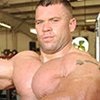
4 Advanced Moves For Extreme Arm Growth!
What do you get when you combine advanced training techniques with proven arm exercises? A recipe for guaranteed biceps and triceps growth!
There are so many muscle growth "secrets" being uncovered these days that Victoria herself would be exhausted checking them all out. But those of us in the strength business know there's no secret: Your genetics deal the cards, but your training plays the hand.
In other words, don't believe the hype surrounding flashy training programs that promise big results in a short amount of time. Your approach to arms doesn't have to be exotic to work wonders—but it might have to be a little eccentric to knock you into growth mode.
Every movement here is one you know, but you've probably never performed them quite like this. These techniques have been tried in the trenches on both hard-gainers and pro bodybuilders—not to mention plenty of average Joes in between—and the results have been overwhelmingly positive.
Single-Arm Eccentric Barbell Curl
This movement was taught to me by my mentor, the always innovative Charles Poliquin. Why the emphasis on the eccentric—or lowering—part of the movement? Because eccentric-overload training is a potent muscle-building tool that preferentially recruits fast-twitch muscle fibers. Sparing you a science symposium, these are the fibers with the most potential for growth.
Even if you've never eaten at Waffle House, I bet you can guess what they serve. Like the Waffle House, the single-arm eccentric barbell curl has a self-explanatory name. Yes, you read that correctly—barbell, not dumbbell. The width of the bar makes this movement very awkward, which forces you to use your supinator muscles to keep the barbell steady and parallel to the floor.
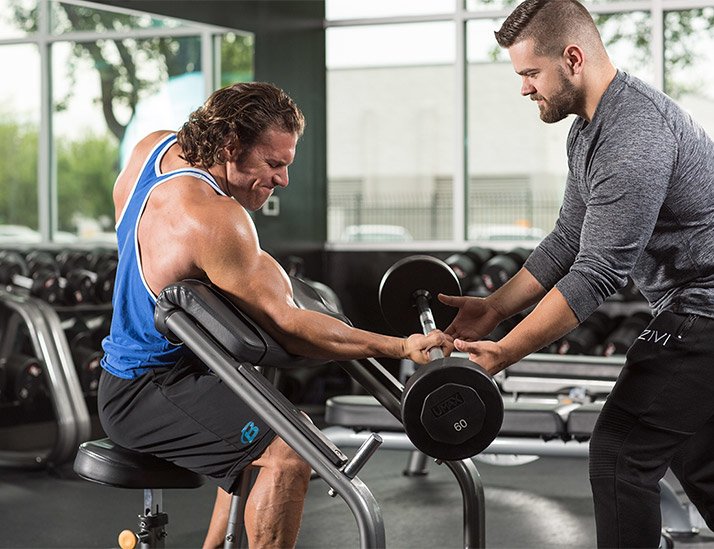
How to do it
Perform the movement on a preacher bench, starting with the loaded arm at the top of the movement. Then simply lower the barbell over an eight-second count. Stop briefly at the bottom, and have a training partner assist you on the concentric portion of the rep.
If you train alone, you can use your nonworking hand for support, but don't curl the weight. All the work should be on the eccentric!
Technique tips
- Growth is the objective, but keep in mind each rep takes eight seconds alone on just the negative, so keep reps in the range of 3-5 for 3-6 sets.
- You're as much as 1.6 times stronger eccentrically than concentrically, so that means you must go heavy. Choose the highest weight that allows you to meet those rep marks and set marks.
- End a set if you can no longer maintain a steady eight-second eccentric tempo. If you didn't meet the minimum rep threshold (three), reduce the poundage.
- Eccentric overload training takes much longer to recover from than traditional training, so don't use this movement during a lower-intensity phase. And be prepared to be sore!
Timed Triceps Extension Cluster Sets
The bent-over rope triceps extension is an incredibly effective triceps isolator that builds muscle. Unlike most effective triceps single-joint movements, it spares trauma to the elbow joint. The exercise itself may be rather ordinary, but this approach—using timed cluster sets—is brutally effective.
Cluster sets simply mean you perform more sets and fewer reps per set. Olympic lifters have used cluster sets for more than half a century, and powerlifters have for decades. Today, even more physique athletes are getting on board. I've used this technique when training IFBB pro bodybuilders Johnnie Jackson, Cory Mathews, and Branch Warren. The difference here is all about how you manipulate the rest and workload.
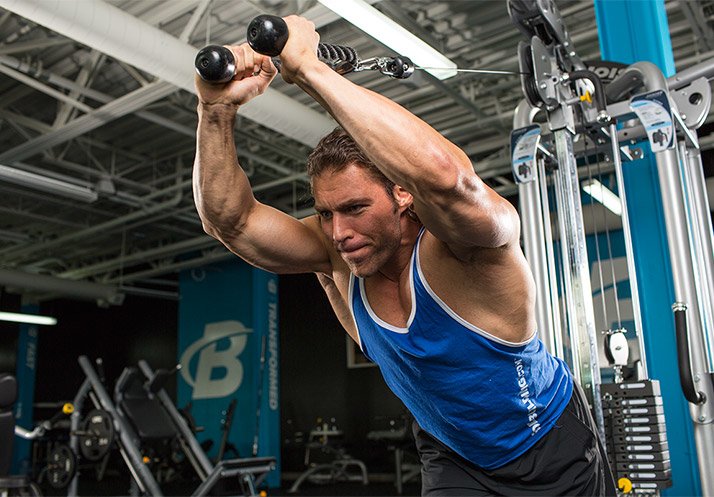
How to do it
Instead of your traditional 3 sets of 12 overhead rope extensions using a weight that allows you to barely reach 12, use the same weight for just 5 reps, then rest 15 seconds—and only 15 seconds—and repeat this sequence for five minutes straight. You'll get in a helluva lot more volume this way, but in far in less time!
Bonus: To provide your arms with a nice growth shock, perform all of your biceps and triceps exercises in this cluster fashion 1-2 times a week for three weeks.
Technique tips
- Use a split stance for better balance.
- Start each set by bending over and elevating your upper arms so they're beside your head. This targets the long head especially well.
- Any time you can't complete 5 reps in a set, reduce the poundage slightly to push you back up.
Eccentric Reverse Fat-Bar Curl
To perform the reverse curl, grab the bar with a pronated (overhand) grip. This targets the brachialis, a muscle that's not visible but lies underneath the biceps and is a workhorse in elbow flexion. A well-developed brachialis increases arm size and creates a better peak. If you can't reverse curl approximately 80 percent of what you can do with regular curls, you're leaving arm size on the table, according to Poliquin.
Of course, your grip will also get serious work here, thanks to the fat bar. If you don't have access to one, use some Fat Gripz to turn a barbell or dumbbell into a fat handle.
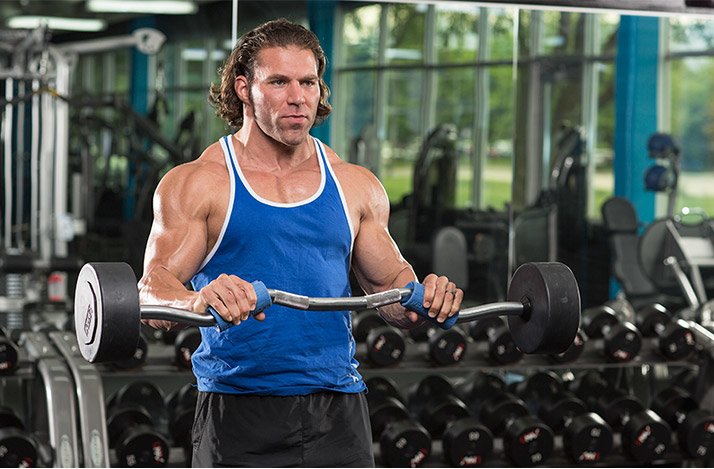
How to do it
Since the brachialis is often neglected, the goal here is to bring its strength up to snuff while maximizing time under tension. This can be accomplished by keeping your reps in the 3-6 range and your sets in the 4-6 range, going as heavy as possible.
Perform the concentric portion of the rep quickly but under control, without using additional momentum. Lower the weight at a steady five-second pace.
Technique Tips
- Keep your elbows tight to your sides; don't let them drift forward in an attempt to take the bar higher. Elbow drift means the front delts get recruited into the movement.
- End your set if you can no longer maintain a steady five-second eccentric tempo. If you didn't meet the minimum rep threshold of three, reduce the poundage.
Weighted Dip and Triceps Extension Giant Set
For maximum muscular development, you must train with a wide variety of weights, rep ranges, tempos, and movements. This painful four-exercise giant set starts heavy and ends in extreme fatigue, taxing fast-twitch, slow-twitch, and intermediate fibers.
Why dips? The ground-breaking bodybuilding text, "Target Bodybuilding" by Per Tesch, PhD, showed through magnetic resonance imaging that dips maximally target all three heads of the triceps. This is why they've been a staple in the routines of top bodybuilders and strength athletes for over a century.
You'll hit them heavy here, adding weight as necessary, and then jump right into a burner of a dumbbell triset I learned from trainer Joe Giandonato.
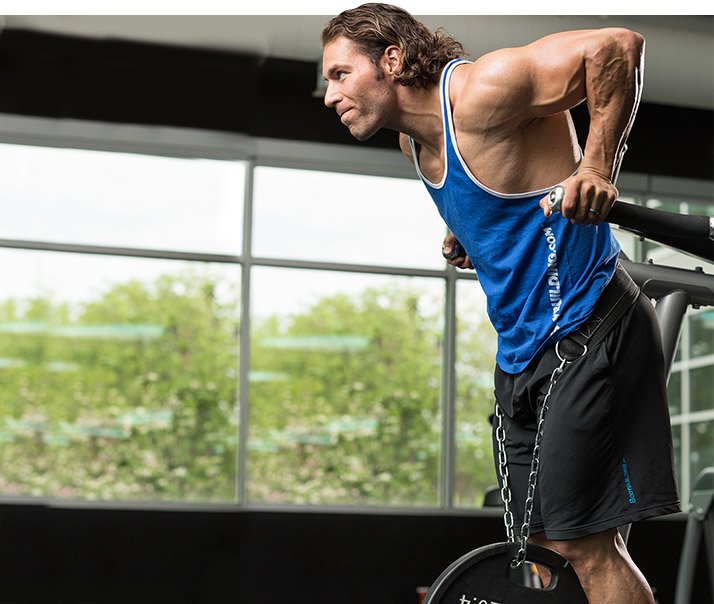
How to do it
For the dips, use as much weight as necessary to do just 5-8 reps. I prefer chains for weight if you have access to them, or you can add weight with a dip belt.
When you're done with dips, grab a pair of dumbbells. Joe recommends using about 30 percent of the load you could use on dumbbell bench presses for 10 reps. So, if you can handle 100s for a set of 10, use 30s here. Lie down on a flat bench and perform these movements in a single, seamless series:
- One rep of a neutral-grip dumbbell close-grip bench press
- One rep of a skullcrusher, starting from the top locked-out position and hinging at the elbows until the dumbbells are next to your head
- One rep of a pull-over, starting from the locked-out position and going slightly behind your head
Those three exercises performed together equal one rep. You'll be doing 10 of these "super reps" per set—although it's really a total of 30 reps overall. It may sound a bit complicated at first glance, but in action it's simple.
You can see bodybuilder Tyrus Hughes demonstrating the entire sequence in "Terrorizing the Triceps."
Terrorizing the Triceps, Part 1 with Tyrus Hughes and Josh Bryant
Watch the video - 3:03
Technique Tips
- Unlike dips for chest, try to control elbow flare as much as possible here, and keep your body as vertical as possible.
- As you fatigue—and you will—reduce the weight in increments of about 10-15 percent so you can still reach the rep targets.
- If you want to go extra heavy on the dips, use a Slingshot, which will take some of the stress off your chest and shoulders and massively overload the triceps.
